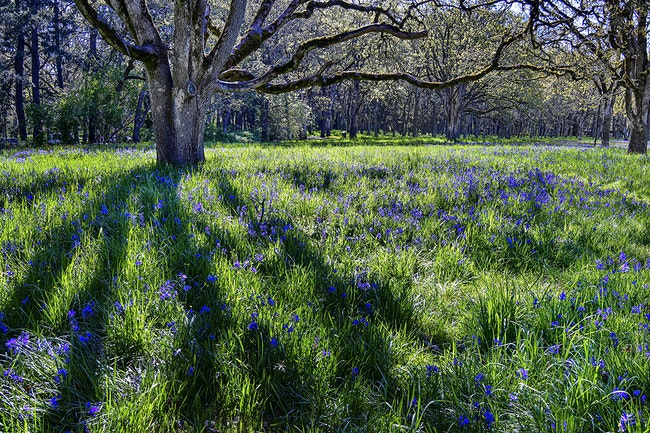
An oak tree casts a long, early morning shadow across a field of camas root in bloom at Bush’s Pasture Park in Salem. (Ron Cooper/Salem Reporter)
John Nohr, the fire chief for parts of Clark and Cowlitz counties in Washington state, was driving down Interstate 5 when another firefighter asked if he’d noticed the trees.
It was June 29 — one day after the hottest day in both Portland’s and Vancouver’s histories — and Nohr turned to see the needles on every fir tree had turned brown on the side facing the sun, seemingly overnight. On Interstate 205, he saw the same.
For Nohr, who has spent his entire life in the Northwest, it was a first. It was also cause for concern.
Last month’s heat dome left trees across the Portland metro area, and much of the state, browning and dried up. With little moisture in the forecast, those stands of trees pose a risk of turning into major fires.
A healthy tree can resist a small fire, Nohr said. But with dead needles all on one side, a fire could easily climb to the top of the tree. At that point, even green needles on the tree could not resist the heat, allowing the flames to spread and set other trees ablaze.
“Before you know it, you’ve essentially got a fire that’s out of control,” Nohr said. “It’s potentially hard for us as a fire department to bring that many trees under control quick enough before they spread to houses and things like that.”
Evergreen trees can turn brown and become fire risks for many reasons. What’s different now is how many trees have been affected by extreme weather.
And it wasn’t just the June heat wave.
“When there are extreme wildfires on the west side of the Cascades, that is usually associated with multiple months of drought proceeding those wildfires,” said Aaron Groth, an Oregon State University Extension regional fire specialist for the Oregon Coast. “In this case, we’ve had a real dry spring, we’ve had the heat dome over the Pacific Northwest, and that has really dried fuels out across the region.”
Lisa Tadewaldt, an arborist for Urban Forest Pro in Portland, said heat exacerbated damage from February’s ice storm — which caused the worst damage in 35 years to trees in the Willamette Valley — as well as the ongoing drought.
“What does 115-degree weather do to trees in Oregon?” Tadewaldt asked. “Anyone that pretends to know is lying.”
This year’s extreme weather came after six years of generally poor conditions in the Willamette Valley — high temperatures, low humidity and drought. Even for trees that have remained intact for 100 years, a single year of extreme weather events can tip them over the edge.
“They suffer kind of an internal failure, and they just die very suddenly,” said Glenn Ahrens, an OSU Extension forester. “And people are looking for disease or an insect to blame, but it’s really just climate stress.”
To stay cool internally, trees rely on water flowing through their trunks and limbs and evaporating in their leaves. But when exposed to intolerable heat — particularly on an “open edge,” such as the unshaded end of a forest — leaves may not be able to cool down, which can be all it takes to kill a tree, Ahrens said.
The risk of damage is heightened for trees along a highway, where the impact of direct sunlight on the foliage is compounded by heat radiating off the pavement.
When the combined stress from heat and drought weakens a tree, it can also become more vulnerable to other threats, like insects or diseases.
“The summers have been hotter and hotter, and it’s been really hard on the evergreens,” Tadewaldt said. Typically, by the time needles have turned visibly brown, “there’s no stopping it, and the whole tree is just going to die.”
In some cases, Ahrens said he expects the heat dome and drought will have lasting consequences on Oregon’s tree canopy. Even the trees that don’t die quickly due to the heat and drought may be more vulnerable to future weather events, particularly if another arrives this summer.
It’s not uncommon to see isolated populations of trees suffering after a run of extreme weather.
“We see versions of this,” Ahrens said. “It’s just this was such a widespread and extreme event that we’re seeing it everywhere.”
— Reporter Ardeshir Tabrizian can be reached at [email protected]; 503-221-8067; @ardytabrizian
This story published with permission as part of the AP Storyshare system. Salem Reporter is a contributor to this network of Oregon news outlets.
JUST THE FACTS, FOR SALEM – We report on your community with care and depth, fairness and accuracy. Get local news that matters to you. Subscribe to Salem Reporter starting at $5 a month. Click I want to subscribe!










